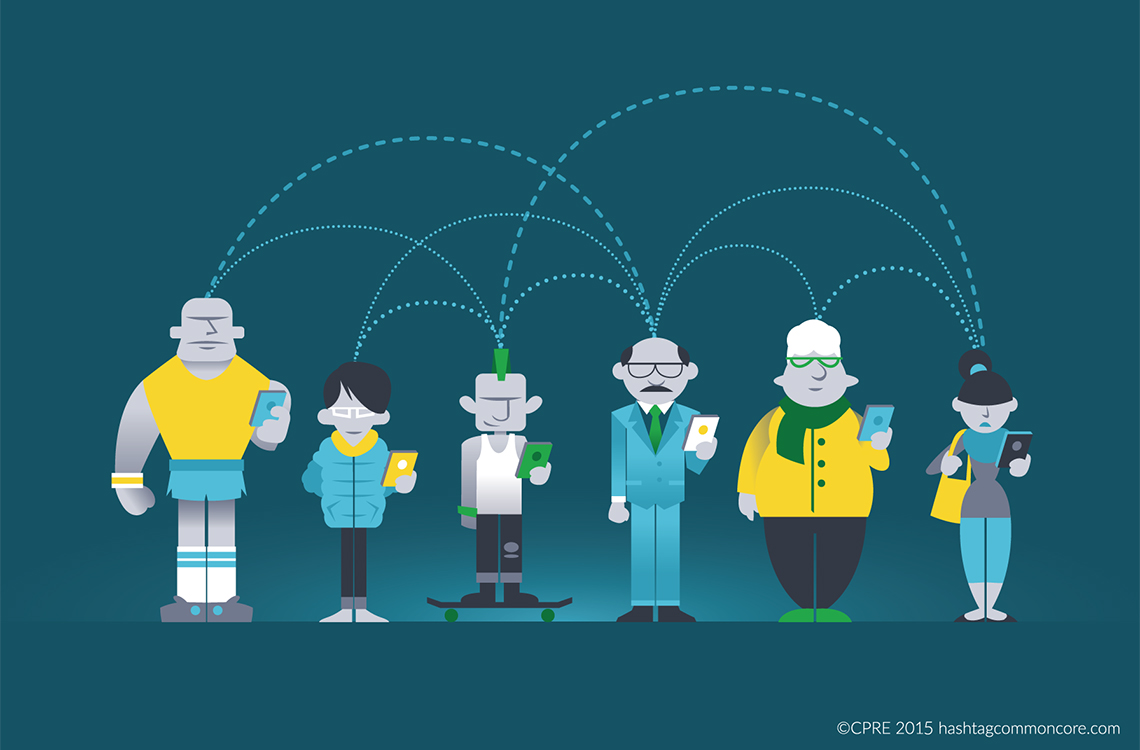About the Project
In the #commoncore Project, authors Jonathan Supovitz, Alan Daly and Miguel del Fresno, examine the intense debate around the Common Core State Standards education reform as it played out on Twitter. The Common Core, the major education policy initiative of our generation, seeks to strengthen education systems across the United States through a set of specific and challenging education standards. Once enjoying bipartisan support, the controversial Standards have become the epicenter of a heated national debate about this approach to educational improvement. By studying the Twitter conversations about the Common Core, we shed light on the ways that social media—enabled social networks are influencing the political discourse that, in turn, produces public policy.
The Rise of Social Media—Enabled Social Networks
We live amidst an increasingly dense technology-fueled network of social interactions that connects us to people, information, ideas, and events which together inform and shape our understanding of the world around us. In the last decade, technology has enabled an exponential growth of these social networks. Social media tools like Facebook and Twitter are engines of a massive communication system in which a single idea can be shared with thousands of people in an instant.

Twitter, in particular, represents a compelling resource because it has become a kind of “central nervous system” of the Internet, connecting policymakers, journalists, advocacy groups, professionals, and the general public in the same social space. Twitter users can share a variety of media including news, opinions, web links, and conversations in a publicly accessible forum.
In this project we use Twitter to analyze the intense debate surrounding the Common Core State Standards. The Common Core has consistently generated a high volume of activity on Twitter. Hashtags (#) are used on Twitter to mark keywords or topics of interest to users, and one hashtag in particular, #commoncore, has consistently generated 30,000-50,000 tweets a month. While topics tend to trend and fall on Twitter, #commoncore has consistently maintained this volume of activity over the past 18 months and continues to be the most prevalent marker of conversations about the Common Core State Standards education reform.
Social Network Analysis Makes the Invisible Visible
To understand the #commoncore network, we use social network analysis as a lens to explore the ways that social media—enabled social networks are influencing the political discourse that produces public policy.

The powerful thing about social network analysis is that it makes visible the patterns of communication in social networks that are otherwise invisible to either those interacting within the networks or those observing them from the outside. Regardless of whether they are networks of neighbors talking across backyard fences or friend networks on Facebook, social networks are mostly invisible to the naked eye, similar to the way in which television signals are always flowing above and around us but we are generally oblivious to their presence. Despite being unseen, the ideas and messages transmitted via social media like Twitter can be very consequential in terms of the type, accuracy, and novelty of the information that is being broadcast, and with whom it is being shared. These sources help form our beliefs and opinions, and it is these convictions upon which our actions are based.
How Our Story Is Organized
The story of the #commoncore communication system is organized into a prologue, four acts, and an epilogue:
- The Prologue is designed to give you a broad context for our investigation of the Common Core on Twitter. It includes this introduction to the project, as well as sections on the evolution of media in politics and the history of standards based reform. It also includes a short primer on the theory of social capital, which is the concept underlying the importance of social networks. The prologue also includes a short overview of how Twitter works for those unfamiliar with the social media tool.
- Act 1 focuses on The Social Network and its subgroups. The act begins with a short overview of the data we analyzed for the project. We then introduce you to the giant #commoncore network and structural communities that are formed by their patterns of activity on Twitter. The structural communities are not our interpretation of the data, but are based upon actors’ actual choices and behavior on Twitter. The members of these subgroups have distinct characteristics and tend to share similar beliefs and opinions. We also introduce two types of influential actors on Twitter, transmitters, who send lots of tweets, and transceivers, whose messages are deemed so important that their communications are frequently re-sent and mentioned by others.
- Act 2: The Players introduces the particular key individuals and organizations in the #commoncore network. These include:
- The individuals who compose the Transmitter network, or those who send lots of tweets using #commoncore.
- The individuals who comprise the Transceivers network, or those whose tweets are frequently retweeted or mentioned by others, giving them a different kind of influence in the #commoncore network.
- The Transcenders, who are both high-frequency transmitters and transceivers. In the #commoncore network, these actors are the elite of the elite.
- Each of these types of players has an important role in the overall communication system. Their patterns of behavior offer insights into both the overall structure of the communication network and their positions within it.
- Act 3: The Chatter hones in on the specific content of the #commoncore tweets of the key individuals introduced in Act 2. This act provides insight into the politics, opinions, and goals of the members of the network through analysis of the political language and metaphors they use in their #commoncore tweets.
- Act 4: The Motivations delves into the passions and deeply held beliefs of a small sample of prominent actors in the #commoncore network. It features audio interviews with some of the players, spotlighting their arguments for or against the Common Core as well as the motivations behind their social advocacy.
- The Epilogue distills the big takeaways from our exploration. It includes a summary of the key findings and essays about the meaning of the findings. Jonathan Supovitz’s essay examines the rise of crowd-sourced political influence represented by the #commoncore phenomenon. Alan Daly considers larger questions of the role of social space in public debate. And Miguel del Fresno writes about the ongoing innovative disruption of social media.
Funding
This project received no external funding from any source.
About the Authors
The creators of the #commoncore Project are:
- Jonathan Supovitz, the co-director of the Consortium for Policy Research in Education and a Professor of Education Policy and Leadership at the Graduate School of Education at the University of Pennsylvania.
- Alan Daly, the Chair of the Department of Education Studies and a Professor of Education at the University of California, San Diego.
- Miguel del Fresno, a lecturer at the Universidad Nacional de Educación a Distancia (UNED) in Madrid, Spain and a senior communication consultant and researcher.
Citation
Supovitz, J., Daly, A., & Del Fresno, M. (2015, Feb 23). #commoncore Project. Retrieved from http://www.hashtagcommoncore.com


